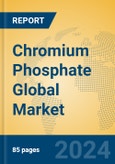Introduction
Chromium Phosphate (CrPO4) is a green crystalline compound valued for its excellent anti-corrosion properties, primarily used as a rust-preventive pigment in coatings, as well as in dyestuffs, plating, and surface treatments. Its high thermal stability, with a melting point of 1800°C, makes it an ideal bonding agent for refractories and ceramics. The chromium phosphate industry is characterized by its critical role in protective coatings for industries like automotive, aerospace, and marine, driven by demand for durable, corrosion-resistant materials. Key trends include the development of eco-friendly coating formulations, high-purity grades for advanced applications, and enhanced safety protocols due to its chemical properties. The market is propelled by growth in infrastructure and industrial coatings, particularly in Asia Pacific and North America.Market Size and Growth Forecast
The global Chromium Phosphate market was valued at USD 120-210 million in 2024, with an estimated CAGR of 4.8%-6.8% from 2025 to 2030, driven by demand in coatings and surface treatments.Regional Analysis
- North America is projected to grow at a CAGR of 4.6%-6.6%, with the U.S. leading due to its automotive and aerospace sectors, focusing on high-performance chromium phosphate coatings.
- Europe is expected to achieve a CAGR of 4.3%-6.3%, with Germany driving demand through its emphasis on eco-friendly coatings and refractories.
- Asia Pacific is anticipated to record the highest growth at 5.2%-7.2%, led by China, where infrastructure and automotive industries fuel demand, with trends toward cost-effective production.
- Rest of the World, particularly Brazil, is expected to grow at 4.0%-6.0%, supported by industrial and marine coating applications.
Application Analysis
- Dyestuff applications are estimated to grow at a CAGR of 4.7%-6.7%, driven by chromium phosphate’s use in ceramic and textile dyes, with trends toward vibrant and stable colorants.
- Plating applications are projected to expand at 4.5%-6.5%, supported by demand in metal finishing for corrosion resistance, with innovations in trivalent chromium processes.
- Surface treatment applications are expected to grow at 4.8%-6.8%, focusing on anti-corrosion coatings for steel, aluminum, and magnesium, with trends toward eco-friendly formulations.
- Other applications, including refractories and ceramics, are anticipated to grow at 4.3%-6.3%, with advancements in high-temperature bonding agents.
Key Market Players
Nippon Chemical Industrial, headquartered in Tokyo, Japan, produces chromium phosphate for coatings and refractories, known for its advanced chemical manufacturing.Oxkem, based in Reading, UK, supplies chromium phosphate for surface treatments and plating, focusing on sustainable production.
Nihon Kagaku Sangyo, headquartered in Tokyo, Japan, provides chromium phosphate for dyestuffs and coatings, emphasizing high-purity production.
Porter’s Five Forces Analysis
- The threat of new entrants is low; high technical expertise and regulatory compliance requirements create significant barriers.
- The threat of substitutes is moderate; alternative anti-corrosion pigments, such as zinc phosphate, compete, but chromium phosphate’s thermal stability and adhesion properties maintain its edge.
- Buyer power is moderate; coating and refractory manufacturers negotiate pricing, but specialized applications limit their leverage.
- Supplier power is low; raw materials like chromium and phosphate are widely available, reducing supplier influence.
- Competitive rivalry is moderate; players differentiate through eco-friendly and high-purity formulations to capture market share.
Market Opportunities and Challenges
Opportunities
- Increasing demand for anti-corrosion coatings in automotive and infrastructure sectors drives chromium phosphate adoption.
- Expansion of refractory and ceramic applications enhances market opportunities.
- Emerging markets in Asia Pacific, particularly China, offer growth potential due to infrastructure development.
Challenges
- Strict regulatory oversight on chromium compounds increases compliance costs.
- Health and environmental concerns related to chromium exposure limit adoption in developed markets.
- Competition from alternative anti-corrosion pigments poses a challenge to market share.
Growth Trend Analysis
The Chromium Phosphate market is experiencing steady growth, driven by its role in anti-corrosion coatings and refractories. Chromium phosphate is a superior rust-preventive pigment used in primers and coatings for ships, aircraft, automobiles, railways, and bridges, offering strong adhesion to steel, aluminum, and magnesium. Its anhydrous form, with a melting point of 1800°C, serves as a bonding agent in refractories and ceramics due to its thermal stability. These applications align with a projected CAGR of 4.8%-6.8% through 2030, reflecting chromium phosphate’s importance in industrial coatings and high-temperature materials.This product will be delivered within 1-3 business days.
Table of Contents
Companies Mentioned
- Nippon Chemical Industrial
- Oxkem
- Nihon Kagaku Sangyo








